Dance of Stones
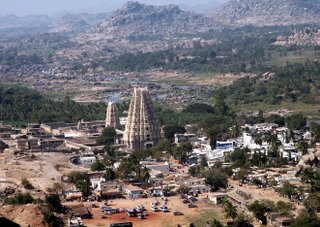
History bears testimony to the fact that when wars were fought not only the warriors but also the culture and arts got vanquished. And this happened to Vijayanagara too. When the end came in 1565 at the battle of Talikota, the well planned and laid out city of trade, culture and administration, was literally razed to the ground. Many of the magnificent structures were completely demolished with their remnants today visible only up to plinth levels while others stood pillaged at different levels. Today Hampi treasures the ruins of the erstwhile Vijayanagara Empire and a visit to this UNESCO World Heritage Site is nothing less than a walk through those historic times. The marvelous stonework in an area of around 27 square kilometers can help gauge the might of the old empire. With stones everywhere; from huge boulders strewn all around Hampi to massive architectural stonework, in places sacred as well as of royal splendour, it is, in fact, a dance of stones.
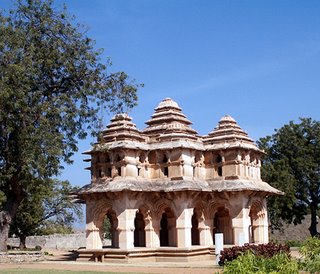
Some remarkable monolith stone figures are Kadalekalu Ganesha (4.5m), Sasuvekalu Ganesha (2.4 m), Ugra Narasimha (6.7 m) and Badavi Sivalinga (3.0 m). A large water storage tank with a manhole, an inlet and outlet bores, all done in a single stone lies in front of the Krishna temple. Large stone beams and joists have been exclusively and artistically used as roofing components in various structures. In the Krishna temple alone, the beams of size approximately 1.5 feet by 2.0 feet across, span openings measuring about 16 feet or more. The curved stone slabs used as projections over palace and temple walls are unique structural marvels.
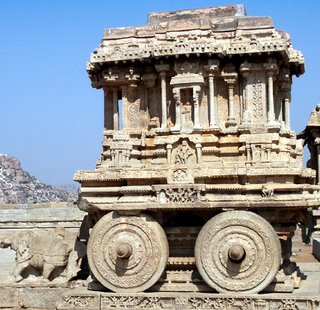
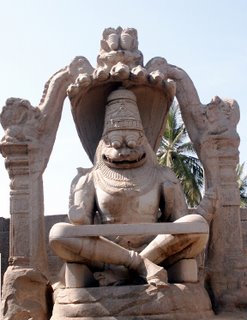
Visitors can stay at Hospet (365 km from Bangalore) where excellent lodging facilities are available to suit every budget. Guesthouse accommodation is also available at Hampi, which is 13 km or 30 minutes by bus from Hospet. The Karanataka State Transport Department runs a very efficient bus service every hour to the heritage site. Daily tours are arranged by the Tourism Department. There is a small but fully functional Karnataka Tourism office in Hampi where an official helps you with detailed information, relevant tourist literature and engagement of guides. Autorickshaws, cycles, and motorcycles are available for hire. Rates are negotiable. I'd suggest a mixture of transportation modes including exploring some places, particularly the northern part, entirely on foot. How much time you need for covering Hampi is an irrelevant question. It differs with the taste and attitude of the visitor. Our guide said five to seven days of leisure were the bare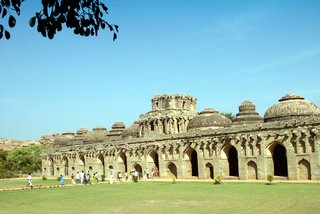 minimum to absorb this wonder. However, for those with hectic schedules to follow, a two-day period was absolutely necessary to have a fleeting but fulfilling glimpse. The single day conducted tour managed by the Karanataka State Tourism is, in my opinion, inadequate; except for school children. So make up your mind and move as under.
minimum to absorb this wonder. However, for those with hectic schedules to follow, a two-day period was absolutely necessary to have a fleeting but fulfilling glimpse. The single day conducted tour managed by the Karanataka State Tourism is, in my opinion, inadequate; except for school children. So make up your mind and move as under.
Day One
Start at the Virupaksha temple right in the heart of village Hampi. The temple stands in reverence to Pampapati - the reigning deity of the Empire. At the rear end of the Virupaksha complex there is a dark chamber where one can see the inverted figure of the front gopuram as a pinhole camera effect. Also, there is a temple dedicated to the sage Vidyaranya who is said to be the moving spirit behind the founding of Vijayanagara. Move up towards Hemakuta hilltop to see Jain temples, massive Ganesha idols and the Krishna temple before moving on to the Laxminarasimha and Badavi Linga temples. This Badavi Linga temple was taken up for construction by a poor woman who could not complete it. It remains roofless till date with the installed 'Siva lingam' standing in water. The Ugranarasimha idol has a very imposing presence. Then follows a two-kilometer long stretch of well-maintained road (towards Kamalapura) through coconut fields before you reach the Royal enclosures. There you can visit the underground temple and then the southern part of the royal courts. Everything here is in ruins except for the three structures that survived the plunder of the city. These are the Lotus Palace, the Queen's Bath and the Elephant stables (home of the nine royal elephants). One viewpoint is that these three magnificent structures escaped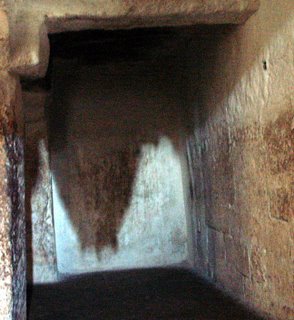 destruction because of the element of the Islamic architecture in them.
destruction because of the element of the Islamic architecture in them.
Mahanavmi Dibba, (the 8-tiered platform where state functions and festivities were held) bears testimony to the destruction carried out by the invaders. A recent find in the palace grounds is an underground water reservoir Pushkarni. The elevated channel meant for feeding water to the tank is made of stone pieces 8 to 10 feet each held in place by vertical props, also of stone. The Hazararama temple is another attraction in this part of Hampi. It has a full depiction of the epic Ramayana besides numerous other figures carved out on its walls.
With this part of Hampi done by the evening, you must return to Hemakuta hillock to have a view of sunset and twilight over the village.
Day Two
You can spend day two exploring the city entirely on foot. About 2 kilometers from Hampi bus stand is the famous Vithala temple complex, the last destination in the northern part. Reach there using a pedestrian track along the Tungabhadra river. On the way, you are bound to hear the amusing tale of 'Sita Haran' (abduction of Sita, Lord Rama's consort) by the demon king Ravana. You would be shown a cave like structure from where she was supposedly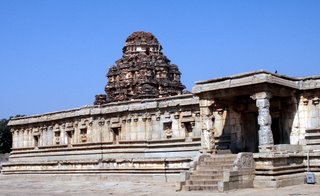 enticed by a sage (Ravana in disguise) and flown out to a distant Lanka. The rest is now history, rather a mythology. The main attraction of the temple complex beside the sculpted structures is the hall of musical pillars where 56 stone columns, on tapping, produce sounds of different musical instruments. The dents on each one of them tell us how extensively these pillars were used for producing musical notes. They say, when the King came in for musical entertainment, the musicians would start tapping the pillars making the hall come alive with melodious tunes. The musical pillars are solid stone structures with no hollow inside. To prove this, one pillar was later sawn down and found all solid. Then there is the Chariot right in front of the hall. Once upon a time the stone wheels could be rotated but not now. They have been cemented. Other main places of interest in the northern part are the King's Balance, the Achutharaya temple, the Courtesans' street, and the Purandara mandap right on the Tungabhadra. There is the Anjali Parbat in the backdrop that gives Hampi a mythological touch.
enticed by a sage (Ravana in disguise) and flown out to a distant Lanka. The rest is now history, rather a mythology. The main attraction of the temple complex beside the sculpted structures is the hall of musical pillars where 56 stone columns, on tapping, produce sounds of different musical instruments. The dents on each one of them tell us how extensively these pillars were used for producing musical notes. They say, when the King came in for musical entertainment, the musicians would start tapping the pillars making the hall come alive with melodious tunes. The musical pillars are solid stone structures with no hollow inside. To prove this, one pillar was later sawn down and found all solid. Then there is the Chariot right in front of the hall. Once upon a time the stone wheels could be rotated but not now. They have been cemented. Other main places of interest in the northern part are the King's Balance, the Achutharaya temple, the Courtesans' street, and the Purandara mandap right on the Tungabhadra. There is the Anjali Parbat in the backdrop that gives Hampi a mythological touch.
The top of Matanga Hill gives a breathtaking view of the scenic beauty around Hampi. Sage Matanga is said to have meditated on top of this hill, hence the name. For a panoramic view, you must trek to the top. A track with stone steps has been laid out from near the Achutaraya temple. My friend and guide Mr. Prabhakar Rao, an officer with NMDC Ltd. inspired and literally pushed me up to the top. This 15-minute steep rise leaves you gasping but it is well worth the effort. It was the first week of January 2005 and the mercury was already above 30 degrees. You can have a fantastic view of the surroundings from the top but not a drop of water to drink. So don't forget to carry some.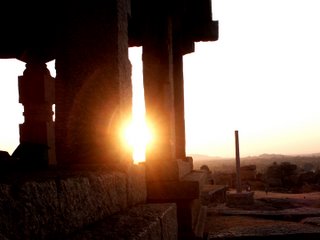
Lastly, a visit to the Kamlapur museum is a must to conclude the visit.
Getting There
Hospet can be reached by an overnight train from Bangalore (The Hampi Express). For visitors from Delhi and Bombay, Guntakal junction (3 hr. from Hospet) is a convenient disembarking location. Hubli is another reachable point on the Bombay – Bangalore / Mysore line.
Best Time to go
Any time after the monsoons. December to February would be the ideal time to visit Hampi.

History bears testimony to the fact that when wars were fought not only the warriors but also the culture and arts got vanquished. And this happened to Vijayanagara too. When the end came in 1565 at the battle of Talikota, the well planned and laid out city of trade, culture and administration, was literally razed to the ground. Many of the magnificent structures were completely demolished with their remnants today visible only up to plinth levels while others stood pillaged at different levels. Today Hampi treasures the ruins of the erstwhile Vijayanagara Empire and a visit to this UNESCO World Heritage Site is nothing less than a walk through those historic times. The marvelous stonework in an area of around 27 square kilometers can help gauge the might of the old empire. With stones everywhere; from huge boulders strewn all around Hampi to massive architectural stonework, in places sacred as well as of royal splendour, it is, in fact, a dance of stones.

Some remarkable monolith stone figures are Kadalekalu Ganesha (4.5m), Sasuvekalu Ganesha (2.4 m), Ugra Narasimha (6.7 m) and Badavi Sivalinga (3.0 m). A large water storage tank with a manhole, an inlet and outlet bores, all done in a single stone lies in front of the Krishna temple. Large stone beams and joists have been exclusively and artistically used as roofing components in various structures. In the Krishna temple alone, the beams of size approximately 1.5 feet by 2.0 feet across, span openings measuring about 16 feet or more. The curved stone slabs used as projections over palace and temple walls are unique structural marvels.


Visitors can stay at Hospet (365 km from Bangalore) where excellent lodging facilities are available to suit every budget. Guesthouse accommodation is also available at Hampi, which is 13 km or 30 minutes by bus from Hospet. The Karanataka State Transport Department runs a very efficient bus service every hour to the heritage site. Daily tours are arranged by the Tourism Department. There is a small but fully functional Karnataka Tourism office in Hampi where an official helps you with detailed information, relevant tourist literature and engagement of guides. Autorickshaws, cycles, and motorcycles are available for hire. Rates are negotiable. I'd suggest a mixture of transportation modes including exploring some places, particularly the northern part, entirely on foot. How much time you need for covering Hampi is an irrelevant question. It differs with the taste and attitude of the visitor. Our guide said five to seven days of leisure were the bare
 minimum to absorb this wonder. However, for those with hectic schedules to follow, a two-day period was absolutely necessary to have a fleeting but fulfilling glimpse. The single day conducted tour managed by the Karanataka State Tourism is, in my opinion, inadequate; except for school children. So make up your mind and move as under.
minimum to absorb this wonder. However, for those with hectic schedules to follow, a two-day period was absolutely necessary to have a fleeting but fulfilling glimpse. The single day conducted tour managed by the Karanataka State Tourism is, in my opinion, inadequate; except for school children. So make up your mind and move as under.Day One
Start at the Virupaksha temple right in the heart of village Hampi. The temple stands in reverence to Pampapati - the reigning deity of the Empire. At the rear end of the Virupaksha complex there is a dark chamber where one can see the inverted figure of the front gopuram as a pinhole camera effect. Also, there is a temple dedicated to the sage Vidyaranya who is said to be the moving spirit behind the founding of Vijayanagara. Move up towards Hemakuta hilltop to see Jain temples, massive Ganesha idols and the Krishna temple before moving on to the Laxminarasimha and Badavi Linga temples. This Badavi Linga temple was taken up for construction by a poor woman who could not complete it. It remains roofless till date with the installed 'Siva lingam' standing in water. The Ugranarasimha idol has a very imposing presence. Then follows a two-kilometer long stretch of well-maintained road (towards Kamalapura) through coconut fields before you reach the Royal enclosures. There you can visit the underground temple and then the southern part of the royal courts. Everything here is in ruins except for the three structures that survived the plunder of the city. These are the Lotus Palace, the Queen's Bath and the Elephant stables (home of the nine royal elephants). One viewpoint is that these three magnificent structures escaped
 destruction because of the element of the Islamic architecture in them.
destruction because of the element of the Islamic architecture in them.Mahanavmi Dibba, (the 8-tiered platform where state functions and festivities were held) bears testimony to the destruction carried out by the invaders. A recent find in the palace grounds is an underground water reservoir Pushkarni. The elevated channel meant for feeding water to the tank is made of stone pieces 8 to 10 feet each held in place by vertical props, also of stone. The Hazararama temple is another attraction in this part of Hampi. It has a full depiction of the epic Ramayana besides numerous other figures carved out on its walls.
With this part of Hampi done by the evening, you must return to Hemakuta hillock to have a view of sunset and twilight over the village.
Day Two
You can spend day two exploring the city entirely on foot. About 2 kilometers from Hampi bus stand is the famous Vithala temple complex, the last destination in the northern part. Reach there using a pedestrian track along the Tungabhadra river. On the way, you are bound to hear the amusing tale of 'Sita Haran' (abduction of Sita, Lord Rama's consort) by the demon king Ravana. You would be shown a cave like structure from where she was supposedly
 enticed by a sage (Ravana in disguise) and flown out to a distant Lanka. The rest is now history, rather a mythology. The main attraction of the temple complex beside the sculpted structures is the hall of musical pillars where 56 stone columns, on tapping, produce sounds of different musical instruments. The dents on each one of them tell us how extensively these pillars were used for producing musical notes. They say, when the King came in for musical entertainment, the musicians would start tapping the pillars making the hall come alive with melodious tunes. The musical pillars are solid stone structures with no hollow inside. To prove this, one pillar was later sawn down and found all solid. Then there is the Chariot right in front of the hall. Once upon a time the stone wheels could be rotated but not now. They have been cemented. Other main places of interest in the northern part are the King's Balance, the Achutharaya temple, the Courtesans' street, and the Purandara mandap right on the Tungabhadra. There is the Anjali Parbat in the backdrop that gives Hampi a mythological touch.
enticed by a sage (Ravana in disguise) and flown out to a distant Lanka. The rest is now history, rather a mythology. The main attraction of the temple complex beside the sculpted structures is the hall of musical pillars where 56 stone columns, on tapping, produce sounds of different musical instruments. The dents on each one of them tell us how extensively these pillars were used for producing musical notes. They say, when the King came in for musical entertainment, the musicians would start tapping the pillars making the hall come alive with melodious tunes. The musical pillars are solid stone structures with no hollow inside. To prove this, one pillar was later sawn down and found all solid. Then there is the Chariot right in front of the hall. Once upon a time the stone wheels could be rotated but not now. They have been cemented. Other main places of interest in the northern part are the King's Balance, the Achutharaya temple, the Courtesans' street, and the Purandara mandap right on the Tungabhadra. There is the Anjali Parbat in the backdrop that gives Hampi a mythological touch.The top of Matanga Hill gives a breathtaking view of the scenic beauty around Hampi. Sage Matanga is said to have meditated on top of this hill, hence the name. For a panoramic view, you must trek to the top. A track with stone steps has been laid out from near the Achutaraya temple. My friend and guide Mr. Prabhakar Rao, an officer with NMDC Ltd. inspired and literally pushed me up to the top. This 15-minute steep rise leaves you gasping but it is well worth the effort. It was the first week of January 2005 and the mercury was already above 30 degrees. You can have a fantastic view of the surroundings from the top but not a drop of water to drink. So don't forget to carry some.

Lastly, a visit to the Kamlapur museum is a must to conclude the visit.
Getting There
Hospet can be reached by an overnight train from Bangalore (The Hampi Express). For visitors from Delhi and Bombay, Guntakal junction (3 hr. from Hospet) is a convenient disembarking location. Hubli is another reachable point on the Bombay – Bangalore / Mysore line.
Best Time to go
Any time after the monsoons. December to February would be the ideal time to visit Hampi.
Nice post. Curiously i am asking my travel planner to see if I could make it to this place during my visit to India this fall
ReplyDelete- Brenda